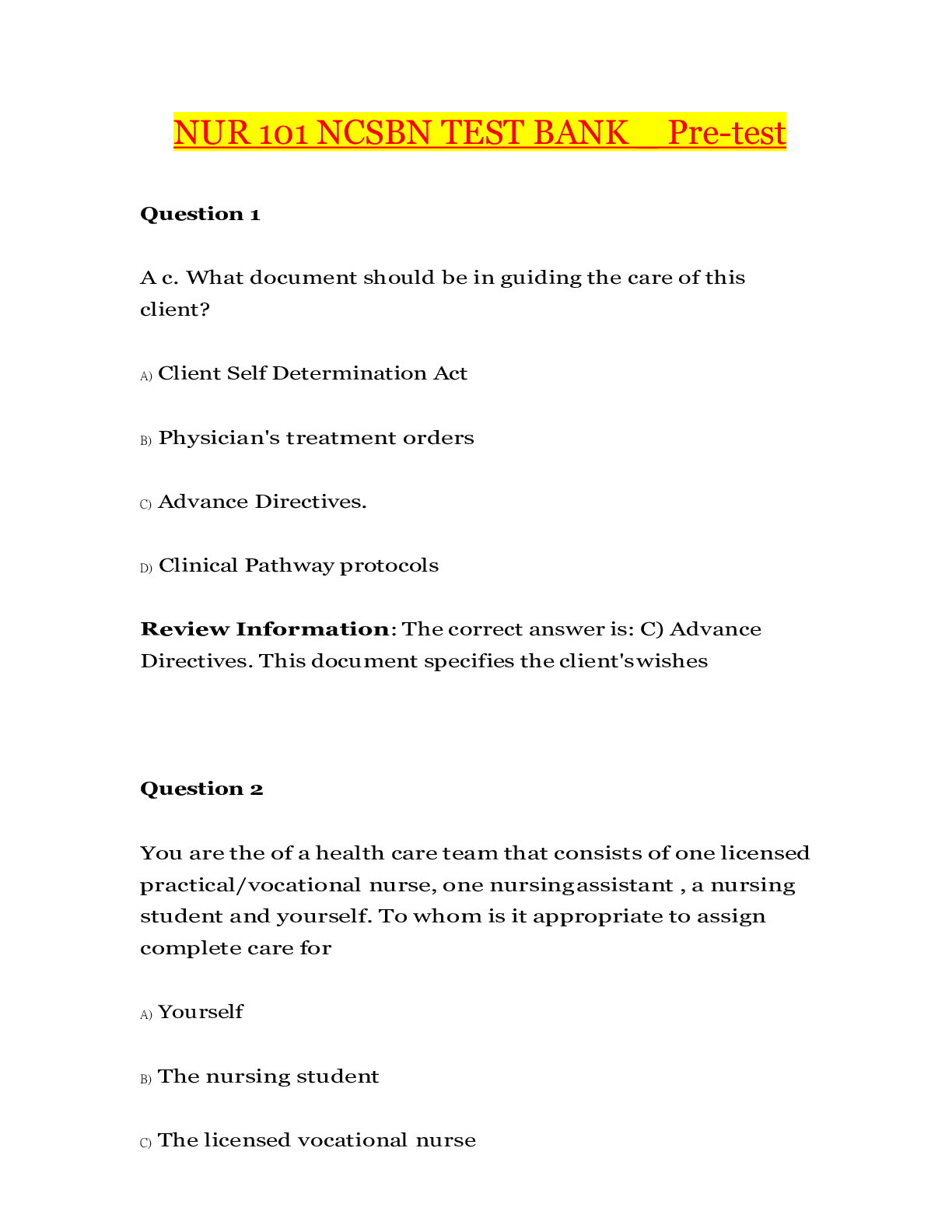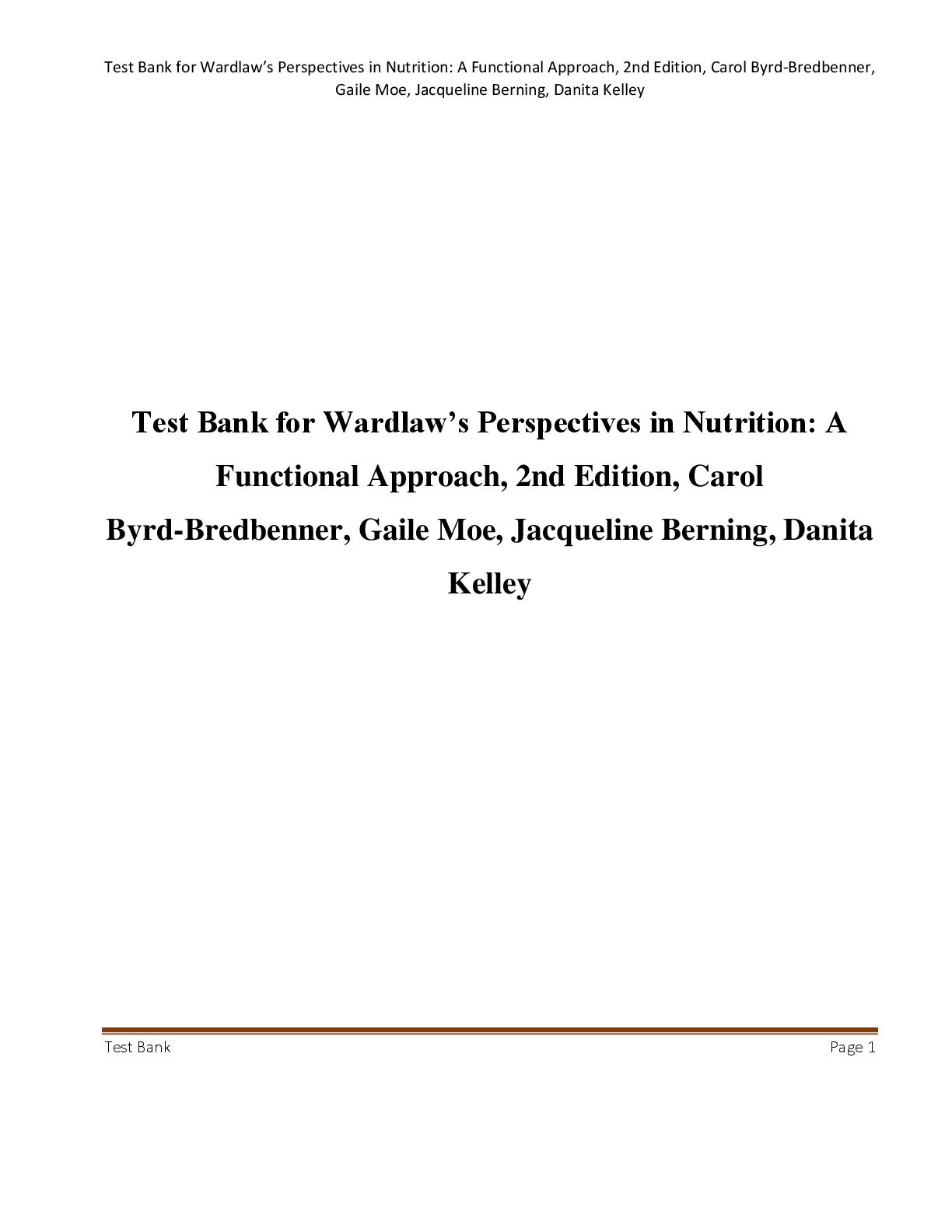Nutrition > TEST BANKS > Test Bank For Wardlaw’s Perspectives in Nutrition- A Functional Approach, 2nd Edition (All)
Test Bank For Wardlaw’s Perspectives in Nutrition- A Functional Approach, 2nd Edition
Document Content and Description Below
Test Bank For Wardlaw’s Perspectives in Nutrition- A Functional Approach, 2nd Edition Perspectives in Nutrition, A Functional Approach, 2e (Byrd) Chapter 2 Tools of a Healthy Diet 1) Which is t... rue about the Dietary Reference Intakes (DRIs)? A) They apply to people in Canada and the U.S. B) They differ by age group. C) They include Recommended Dietary Allowances and Tolerable Upper Intake Levels. D) They were created by the Food and Nutrition Board. E) All of these responses are true. Answer: E Explanation: All responses correct Difficulty: 1 Easy Section: 02.01 Topic: Dietary requirements Learning Objective: 02.01 Explain the purpose of the Dietary Reference Intake (DRI) and its components (Estimated Average Requirements, Recommended Dietary Allowances, Adequate Intakes, Upper Levels, Estimated Energy Requirements, and Acceptable Macronutrient Distribution Ranges). Bloom's: Remember Est Time: 0-1 minute 2) Dietary Reference Intakes (DRI) values are for people who are ________. A) 1 to 4 years of age B) over 4 years of age C) over 19 years of age D) of all ages Answer: D Explanation: DRIs are for people of all ages. Difficulty: 1 Easy Section: 02.01 Topic: Dietary requirements Learning Objective: 02.01 Explain the purpose of the Dietary Reference Intake (DRI) and its components (Estimated Average Requirements, Recommended Dietary Allowances, Adequate Intakes, Upper Levels, Estimated Energy Requirements, and Acceptable Macronutrient Distribution Ranges). Bloom's: Remember Est Time: 0-1 minute 2 Copyright © 2019 McGraw-Hill Education. All rights reserved. No reproduction or distribution without the prior written consent of McGraw-Hill Education. 3) An Adequate Intake (AI) is set for a nutrient when ________. A) too little research is available to establish an RDA B) the needs during pregnancy decline instead of increase C) the set RDA is not adequate enough D) the nutrient has a high potential for being toxic Answer: A Explanation: AI is set when too little research is available to establish an RDA. Difficulty: 1 Easy Section: 02.01 Topic: Dietary requirements Learning Objective: 02.01 Explain the purpose of the Dietary Reference Intake (DRI) and its components (Estimated Average Requirements, Recommended Dietary Allowances, Adequate Intakes, Upper Levels, Estimated Energy Requirements, and Acceptable Macronutrient Distribution Ranges). Bloom's: Remember Est Time: 0-1 minute 4) Which Dietary Reference Intake (DRI) is set high enough to meet the needs of 97 to 98% of the population? A) Estimated Energy Requirements B) Estimated Average Requirements C) Recommended Dietary Allowances D) Dietary Reference Intakes Answer: C Explanation: The RDA is set to meet the needs of 97-98% of the population. Difficulty: 1 Easy Section: 02.01 Topic: Dietary requirements Learning Objective: 02.01 Explain the purpose of the Dietary Reference Intake (DRI) and its components (Estimated Average Requirements, Recommended Dietary Allowances, Adequate Intakes, Upper Levels, Estimated Energy Requirements, and Acceptable Macronutrient Distribution Ranges). Bloom's: Remember Est Time: 0-1 minute 3 Copyright © 2019 McGraw-Hill Education. All rights reserved. No reproduction or distribution without the prior written consent of McGraw-Hill Education. 5) Tolerable Upper Intake Levels (ULs) are ________. A) the maximum daily intake level not likely to cause harmful effects B) based on intakes from only supplements and highly fortified foods C) nutrient intake goals D) set for all nutrients Answer: A Explanation: UL is the maximum daily level not likely to cause harmful effects related to toxicity. Difficulty: 1 Easy Section: 02.01 Topic: Dietary requirements Learning Objective: 02.01 Explain the purpose of the Dietary Reference Intake (DRI) and its components (Estimated Average Requirements, Recommended Dietary Allowances, Adequate Intakes, Upper Levels, Estimated Energy Requirements, and Acceptable Macronutrient Distribution Ranges). Bloom's: Remember Est Time: 0-1 minute 6) Which Dietary Reference Intake (DRI) reflects average daily needs? A) Adequate Intakes B) Estimated Average Requirements C) Recommended Dietary Allowances D) Tolerable Upper Intake Levels Answer: B Explanation: EAR reflects average daily needs. Difficulty: 2 Medium Section: 02.01 Topic: Dietary requirements Learning Objective: 02.01 Explain the purpose of the Dietary Reference Intake (DRI) and its components (Estimated Average Requirements, Recommended Dietary Allowances, Adequate Intakes, Upper Levels, Estimated Energy Requirements, and Acceptable Macronutrient Distribution Ranges). Bloom's: Understand Est Time: 0-1 minute [Show More]
Last updated: 2 years ago
Preview 1 out of 2 pages

Buy this document to get the full access instantly
Instant Download Access after purchase
Buy NowInstant download
We Accept:

Reviews( 0 )
$16.50
Can't find what you want? Try our AI powered Search
Document information
Connected school, study & course
About the document
Uploaded On
Mar 18, 2023
Number of pages
2
Written in
Additional information
This document has been written for:
Uploaded
Mar 18, 2023
Downloads
0
Views
177















